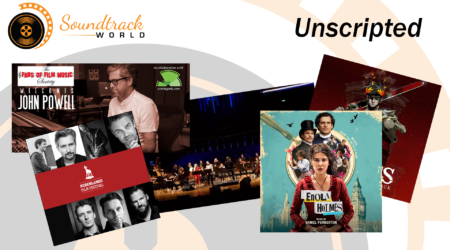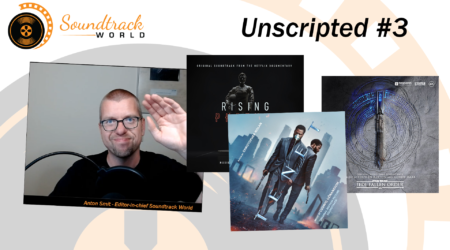
If you had asked me a year ago what the best Spider-Man movie is, I would have said Spider-Man: Into the Spider-Verse in a heartbeat. I have seen many live-action and animated superhero movies, but, in my opinion, Into the Spider-Verse out-classed all of them. This animated feature is about the Spider-Verse, which is the concept that there are many parallel universes that all have some hero with Spider powers. These heroes can be Spider-men, portrayed by Peter Parker or someone else, but they can also be women, clones, animals, robots and so on, which makes them ideally suited for animation. The different animation styles for each Spider-figure, the remarkable story focusing on the new Spider-Man Miles Morales, the brilliant animated sequences, and most importantly, the magnificent score by Daniel Pemberton made it my number one Spider-Man movie. The big question is now, of course, will the sequel Spider-Man: Across the Spider-Verse, with Pemberton as the returning composer, live up to its predecessor?
What made the music for the first movie so amazing is how innovative it was. Only a composer as versatile as Pemberton would come up with the idea to record an orchestra, put that music on vinyl, and let a DJ scratch with that record, which was then used in the score. These scratches blend perfectly with traditional orchestral sounds, other instruments and many fantastic and unique synth sounds. After listening to a couple of tracks from Across the Spider-Verse I got very excited, because Pemberton continued this trend by using the same elements for the music in the sequel. The soundtrack is fun, innovative, unique and well-executed.
The first things that need to be discussed are the themes. Miles Morales’s epic theme does, of course, return in the sequel, with the track “My Name Is… Miles Morales” as a perfect example, not only containing the iconic scratches but with Latin percussion and rhythms added to the mix as well. The other important theme in Across the Spider-Verse is for Spider-Woman Gwen Stacy, who was also introduced in Into the Spider-Verse but has a more prominent role in this sequel. Her theme is laid out in “Spider‐Woman (Gwen Stacy).” The track starts with emotional lines to capture her tough, lonely life, but then the melody transitions into a brilliant poppy song, which can be heard in the movie while she is pulling off her impressive Spider moves.
This movie has some characters with questionable motives. As with the theme for The Prowler from the first movie, Pemberton decided to give them themes that focus more on a specific sound than a melody. The first sound-focused theme is meant for the Spider-Man Miguel O’Hara, and he is portrayed by futuristic synth sounds, reflecting that he is coming from a technologically advanced universe. You can hear his theme in “Spider‐Man 2099 (Miguel O’Hara)”. What I love about the theme is that it does not tell me whether he is a bad person or not. What it does tell me is that he is pretty powerful. The other theme is for the villain Spot. His theme kind of resembles the noises a whale would make, and it sounds very ominous and dangerous. The track “Spot Holes 2” is an excellent example of these sounds.
In addition to O’Hara, two other Spider persons are introduced in the movie. The first one is Spider-Man India, whose music you can hear in “Spider‐Man India (Pavitr Prabhakar).” As you can imagine, Pemberton used quite some Indian elements in the music for him. The other theme is for Spider-Punk, a punk rock-inspired version of Spider-Man, so it should not be a surprise that his theme reflects that music genre brilliantly.
What makes the score for Across the Spider-Verse so outstanding is not only how original and different the themes are from more traditional scores, but also how they are integrated into the film. I did not even discuss all the themes or the goose. Those you have to discover for yourself. The movie has some emotional moments, but there is also a lot of action. While you are watching the stunningly drawn sequences on screen, you notice that all of these moments are superbly supported by Pemberton’s music. None of the tracks are dull, they keep progressing with new music, and most of it is based on some elements of existing themes. For some great examples, listen to the track “Vulture Meets Culture,” in which Stacy’s theme is mixed with a tenor singing some kind of opera; “Mumbattan Madness” that blends many themes into a brilliant cue with a perfect flow; or the last track “Across the Spider‐Verse (Start a Band),” which blends all the musical elements like hip hop, guitars, drums, synth sounds and orchestra into one big finale.
There is one thing that I did not like about Across the Spider-Verse, which dawned on me after two hours of watching the movie, and I noticed the setup to the finale, preparing the audience for a third movie. When I saw “To be Continued” on the big screen, I was a bit disappointed since I could not see how the magnificent story would conclude. Luckily this will also mean that I will experience more hours of this remarkable animated feature soon, and I assume Pemberton will stay on board to write the perfect score for the third movie, Beyond the Spider-Verse, as well. I liked the movie so much that I even think Across the Spider-Verse will take over the number one spot of Best Spider-Man movie, and one of the reasons for that is its music. I genuinely hope that this trend will continue and that Spider-Man: Beyond the Spider-Verse, including its music, will even be better. The bar has been set high.
Listen or buy
- Buy this soundtrack digitally from Amazon.com or Apple Music
- Listen to this soundtrack on Spotify
Tracklist
The highlights are in bold.
- Across the Spider‐Verse (intro) (2:45)
- Spider‐Woman (Gwen Stacy) (3:06)
- Vulture Meets Culture (1:34)
- Spider‐Man 2099 (Miguel O’Hara) (1:02)
- Guggenheim Assemble (4:36)
- The Right to Remain Silent (4:13)
- Across the Titles (0:33)
- My Name Is… Miles Morales (3:22)
- Back Where It All Started (2:57)
- Spot Holes 1 (1:20)
- To My Son (1:42)
- Miles Sketchbook (2:01)
- Under the Clocktower (2:55)
- Rio and Miles (4:24)
- Creation of the Spot (5:02)
- Spider‐Man India (Pavitr Prabhakar) (2:20)
- Mumbattan Madness (2:34)
- Spider‐Punk (Hobie Brown) (2:09)
- Spot Holes 2 (1:11)
- Indian Teamwork (4:42)
- Welcome to Nueva York (Earth‐928) (1:43)
- Spider Society (2:05)
- 2099 Lab (2:35)
- Peter and Mayday Parker (1:38)
- Canon Event (7:09)
- All Stations – Stop Spider‐Man (4:22)
- Hold the Baby (1:12)
- Nueva York Train Chase (5:58)
- The Go Home Machine (4:56)
- Falling Apart (8:23)
- I Beat Them All (2:28)
- The Anomaly (3:46)
- Five Months (2:30)
- Across the Spider‐Verse (Start a Band) (3:53)
Total length: 1 hour and 47 minutes
Sony Classical (2023)




